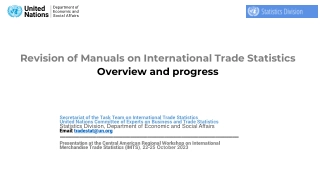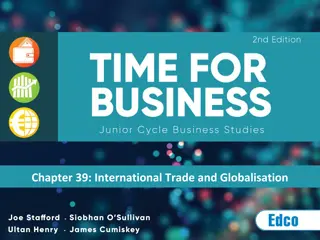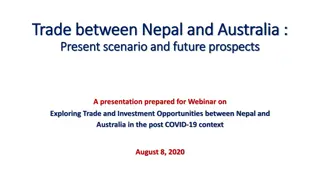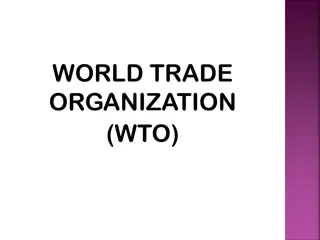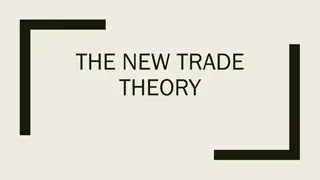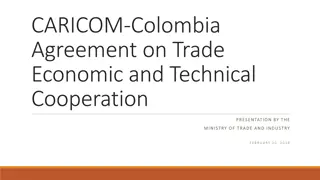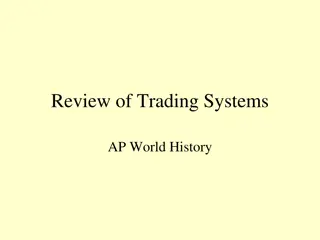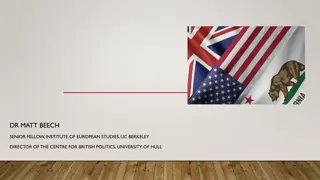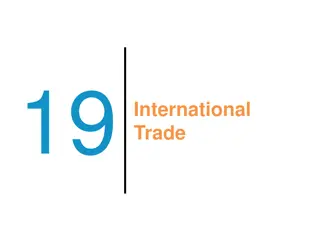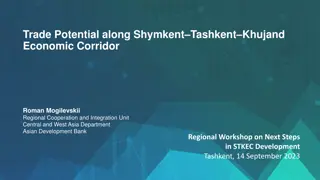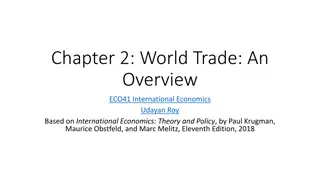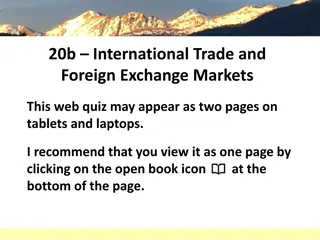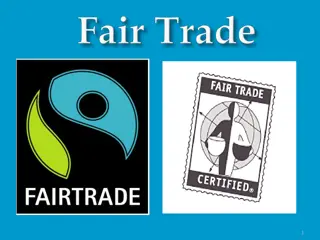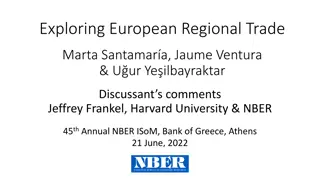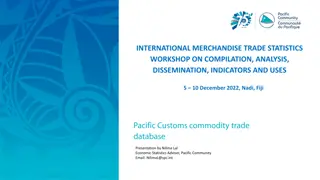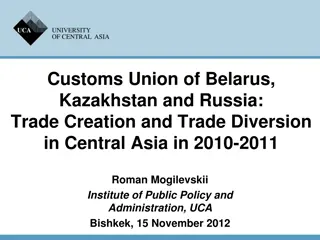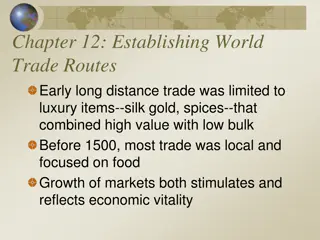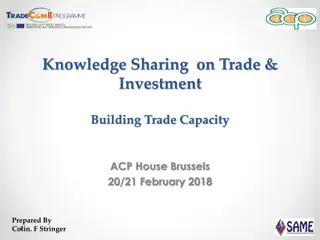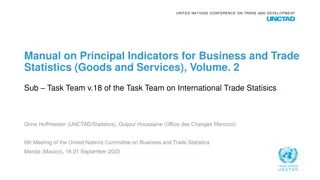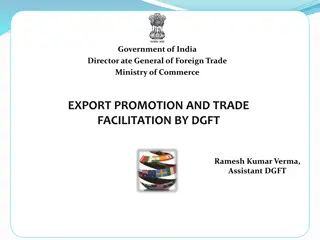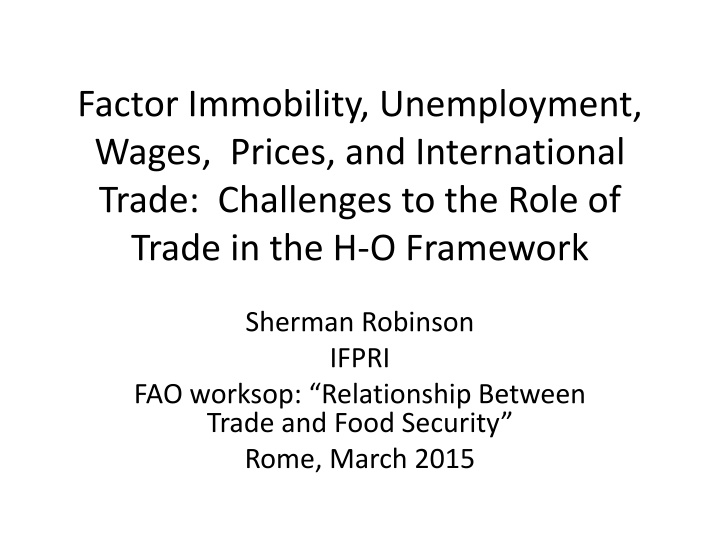
Challenges to Role of Trade in H-O Framework
Factors like immobility, unemployment, wages, and prices pose challenges to the traditional trade theories. This content discusses issues such as factor endowments, international trade benefits, theory of comparative advantage, gains from trade, world prices, and wages in relation to global trade dynamics.
Download Presentation

Please find below an Image/Link to download the presentation.
The content on the website is provided AS IS for your information and personal use only. It may not be sold, licensed, or shared on other websites without obtaining consent from the author. If you encounter any issues during the download, it is possible that the publisher has removed the file from their server.
You are allowed to download the files provided on this website for personal or commercial use, subject to the condition that they are used lawfully. All files are the property of their respective owners.
The content on the website is provided AS IS for your information and personal use only. It may not be sold, licensed, or shared on other websites without obtaining consent from the author.
E N D
Presentation Transcript
Factor Immobility, Unemployment, Wages, Prices, and International Trade: Challenges to the Role of Trade in the H-O Framework Sherman Robinson IFPRI FAO worksop: Relationship Between Trade and Food Security Rome, March 2015
Benefits of International Trade Theory of comparative advantage Necessary and sufficient conditions to generate trade David Ricardo Heckscher-Ohlin-Samuelson (HOS) Major theorems: Trade and Wages Stolper-Samuelson Rybczynski Factor Price Equalization (Samuelson) 2
Theory of Comparative Advantage Countries trade because they are different Technology (Ricardo) and factor endowments (HOS) David Ricardo: Theory of Comparative Advantage Countries differ only in technology: different relative productivity of factors leads to trade Absolute productivity differences do not affect trade HOS: general equilibrium model Different relative factor endowments leads to trade 3
Gains from Trade In moving from autarky, all countries gain: Mutually beneficial exchange The gain arises from being able to consume off the PPF not constrained by production alone Not everyone gains: Producers and factors: some gain, some lose Consumers gain: their effective real income rises, and they change consumption patterns 4
World Prices and Wages Stolper-Samuelson Theorem: Trade matters a lot Relative factor prices are determined solely by relative goods prices Changes in world commodity prices should generate large changes in domestic factor prices: magnification effect Trade policy that affects links between world prices and domestic prices (e.g., tariffs) will have strong effects on wages Trade policy matters a lot 6
Factor Endowments and Wages Rybczynski Theorem Changes in relative factor supplies affect structure of production and trade, but not wages Magnification effect: changes in structure of production are larger than changes in relative factor supplies No role for labor economists and partial equilibrium analysis of labor markets. Wages are determined by general equilibrium trade effects and world prices, not factor endowments. 7
Labor Economists: Partial Equilibrium, Factor Content Analysis Partial equilibrium models: wages determined in the labor market Supply of labor: endowments, skills, education, etc. Demand for labor: technology, demand, trade Unskilled-labor-intensive imports displace unskilled-labor-intensive domestic production Factor content of net trade Worsening of U.S. trade deficit contributes to a widening wage gap because it increases unskilled- labor-intensive imports No room for these effects in trade theory 8
Trade/Wage Debate In the HOS model, world commodity markets drive national factor markets These results are not supported by econometric analysis and simulation models of wage-trade links Stolper-Samuelson and Rybczynski effects are much weaker than theory would predict Econometric analysis of labor markets supports view that wages are sensitive to changes in factor endowments and nature of labor markets 9
HOS Empirical Models Two major issues that the HOS model neglects: Role of non-traded goods Specific factors: tied to particular sectors Non-traded goods Long understood that existence of non-traded goods qualifies the major theorems. How qualified? Specific factors: issues of factor mobility Short versus long run frictions how important? Role of labor markets in trade models 15
Trade Model with Differentiated Goods Expand the HOS model to include goods that are differentiated by country of origin Armington insight: Traded and domestic goods are imperfect substitutes The model can accommodate two-way trade observed in the data: more realistic than HOS Weaker link between world and domestic prices Specification is standard in all trade-focused CGE simulation models 16
Trade-Wages in CGE Models Implications of the Armington assumption Assumption of imperfect substitutability greatly improves the realism of trade simulation models (e.g., CGE models) Robinson, Thierfelder, de Melo, Devarajan and others have worked out the analytics of the HOS model with the Armington specification Trade shares matter substitution/transformation elasticities matter 17
Trade Theorems: Analytic Results Stolper-Samuelson Theorem Sign of wage effect depends on Armington elasticity Magnification effect greatly weakened Rybczynski Theorem Magnification effect greatly weakened Wages change with changes in factor supplies Trade balance changes affect wages Sign opposite from that of labor economists Room for labor economists: endowments matter Migration and skill upgrading more important than commodity prices 18
Trade and Growth: New Trade Theory Trade-productivity-growth links. The failure of standard trade theory to account for growth led to what Thierfelder and Robinson call The Search for Large Numbers Rent seeking, imperfect competition, challenge- response models, research, etc. Stylized facts: globalization, evolution of trade blocs, supply/value chains Need for trade theory to catch up with trends 19
Trade Theory, Regional Integration, Regional Trade Agreements (RTAs) and Economic Development Sherman Robinson IFPRI March 2015
Stylized Facts: Post War 20th Century Dramatic changes in global trade structures Initial dependent trade patterns changed rapidly Emergence of regional trade blocs Increased trade as share of GDP Largest increase in trade among OECD countries Increased trade in intermediate inputs Import content of exports increased International segmentation of production: value chains Strong link between trade and growth No example of rapid growth without rapid trade increase 21
20th Century: Evolution of Trade Blocs In the post-war period, the global trading system recovered from Great Depression and WW II disruptions De-colonization and emergence of new countries with changing economic links Re-orientation of regional trade patterns Emergence of new trade blocs Center-periphery and new regional groupings 22
Shares of Global Trade: 1990s EU+ NAFTA+ E&SE Asia Mercosur SACU+ ROW Total EU+ 33.6 4.2 4.9 0.6 0.3 2.1 45.8 NAFTA+ 3.8 9.8 4.8 0.5 0.1 0.8 19.9 E&SE Asia 4.9 6.8 13.9 0.3 0.1 1.2 27.2 Mercosur 0.4 0.3 0.3 0.4 0.0 0.2 1.6 SACU+ 0.2 0.1 0.2 0.0 0.0 0.1 0.6 ROW 1.6 1.1 1.8 0.1 0.0 0.4 5.1 Total 44.6 22.3 25.9 1.8 0.6 4.8 100.0 30
Implications of New Trade Blocs The formation of blocs pre-dated any explicit regional trade agreement (RTA): very powerful global trends RTAs validate these trends, not cause them Three kinds of RTA: Bloc creation: EU, NAFTA, Mercosur Bloc expansion: EU expansion, CAFTA Market access: EPAs, AGOA, FTAA, TPP, many bilateral agreements RTAs in these categories differ in motivation, scope, and structure goal should be to manage the process 31
New Regionalism Increased geographical dispersion of production through trade that supports (1) exploitation of different factor proportions for parts of the production process (Ricardian efficiency gains) and/or (2) local economies of scale through finer specialization and division of labor in production ( Smithian efficiency gains) Externalities arising from institutional changes and linkages that lead to a wide increase in productivity 32
Trade-Productivity Links Value chains: mechanisms differ from earlier trade-industrialization links Scale economies: Smithian gains Applies to many sectors more economic activity Agriculture, Manufacturing, and Services Consistent with new challenge trade models Melitz model: trade moves producers to the frontier Import Substitution Industrialization (ISI) strategy: no longer relevant the world has changed Policy: facilitate and mange the process, not fight it 33
Shallow and Deep Integration Early RTAs and GATT rounds facilitated shallow integration: Reduction of border trade barriers: PTA, FTA, CU New RTAs involve elements of deep integration Behind the border policies to facilitate trade and value chains: e.g., standards, commercial law, dispute resolution, intellectual property, etc. Trans-Pacific Partnership (TPP) and Trans-Atlantic Trade and Investment Partnership (TTIP) 34
New RTAs: TPP Example Trans-Pacific Partnership: US, Canada, 10 Asia- Pacific countries (does not include China) Deep integration: includes broad range of behind the border regulatory, IP, standards, dispute resolution, and legal issues E.g., regulatory coherence : adopt US methods of evaluating regulatory regimes (cost-benefit analysis) Adopt standard (US) IP (e.g., patent law) 35
New RTAs: TPP Example New dispute resolution mechanism: Investor- State Dispute Settlement (ISDS) Allow foreign companies to challenge domestic laws that damage them before an international panel of arbitrators. Can determine damages, with no recourse to domestic legal system (e.g., national courts). Only international investors (e.g., multinational corporations) have standing not labor unions, etc. Response to worries about corrupt domestic legal systems in developing countries 36
RTAs: TPP Example Dispute resolution and IP issues are especially worrisome for developing countries They are designed to benefit large, multinational corporations Need to create development friendly RTAs Financial sector: regulation issues Response: focus on national treatment : foreign and domestic producers should be treated equally within countries 37
RTAs: Conclusion RTAs that facilitate trade, international value chains, and productivity-trade links are beneficial RTAs need to be development friendly Piketty: return to 19th century levels of inequality Global assault on labor: stagnant wages, attack on unions, pensions, benefits, workers comp insurance Shredding of the social safety net Financial institutions: out of control, destabilizing Deep integration RTAs that facilitate these attacks and trends need to be resisted and modified 38

